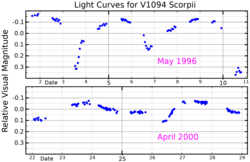 Visual band light curves for V1094 Scorpii, adapted from Wichmann et al. (1998) and Joergens et al. (2001) | |
| Observation data Epoch J2000.0 Equinox J2000.0 | |
|---|---|
| Constellation | Scorpius-Lupus |
| Right ascension | 16 08 36.17701 |
| Declination | −39° 23′ 02.4621″ |
| Apparent magnitude (V) | 13.48 |
| Characteristics | |
| Spectral type | K6V |
| Variable type | T Tauri-type? |
| Astrometry | |
| Proper motion (μ) | RA: −9.830 mas/yr Dec.: +23.435 mas/yr |
| Parallax (π) | 6.5086 ± 0.0452 mas |
| Distance | 501 ± 3 ly (154 ± 1 pc) |
| Details | |
| Mass | 0.92 M☉ |
| Radius | 1.9 R☉ |
| Luminosity | 1.7 L☉ |
| Temperature | 4,205 K |
| Age | 2-3 Myr |
| Other designations | |
| V1094 Sco, GSC 07855-01162, 2MASS J16083617-3923024 | |
| Database references | |
| SIMBAD | data |
V1094 Scorpii is a young stellar object in the constellation of Scorpius, located in the young Lupus Star Forming Region. It is being orbited by a protoplanetary disk that extends out to a distance of 300 AU from the host star. There are gaps at 100 AU and 170 AU, with bright rings at 130 AU and 220 AU.
Periodic radial velocity variations in the young star V1094 Scorpii had at first been explained by the presence of a substellar object in a tight orbit. Currently, the presence of a substellar object has been retracted, invoking starspots as the actual cause for observed radial velocity variations.
References
- Wichmann, R.; Bouvier, J.; Allain, S.; Krautter, J. (February 1998). "Rotational evolution of pre-main sequence stars in Lupus". Astronomy and Astrophysics. 330: 521–532. Bibcode:1998A&A...330..521W. Retrieved 19 March 2022.
- ^ Joergens, V.; et al. (2001). "The T Tauri star RX J1608.6-3922 - not an eclipsing binary but a spotted single star". Astronomy and Astrophysics. 373 (3): 966–973. arXiv:astro-ph/0105326. Bibcode:2001A&A...373..966J. doi:10.1051/0004-6361:20010684. S2CID 17464041.
- ^ Brown, A. G. A.; et al. (Gaia collaboration) (August 2018). "Gaia Data Release 2: Summary of the contents and survey properties". Astronomy & Astrophysics. 616. A1. arXiv:1804.09365. Bibcode:2018A&A...616A...1G. doi:10.1051/0004-6361/201833051. Gaia DR2 record for this source at VizieR.
- ^ van Terwisga, S. E.; et al. (August 2018). "V1094 Scorpii: A rare giant multi-ringed disk around a T Tauri star". Astronomy & Astrophysics. 616: 10. arXiv:1805.03221. Bibcode:2018A&A...616A..88V. doi:10.1051/0004-6361/201832862. S2CID 118972266. A88.
- Hughes, Joanne; et al. (1993). "The distance to the Lupus star formation region". The Astronomical Journal. 105 (2): 571–575. Bibcode:1993AJ....105..571H. doi:10.1086/116454.
- Wichmann, R.; et al. (1997). "T Tauri stars and the Gould Belt near Lupus". Astronomy and Astrophysics. 326: 211–217. Bibcode:1997A&A...326..211W.
This variable star–related article is a stub. You can help Misplaced Pages by expanding it. |